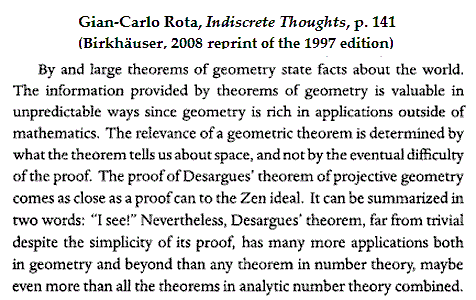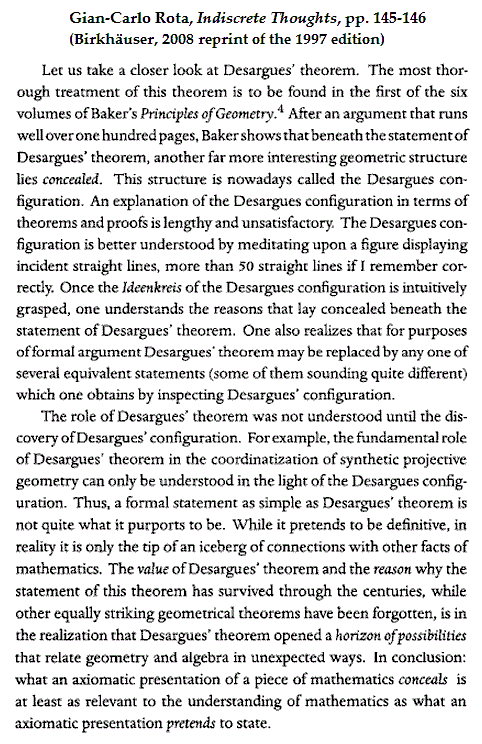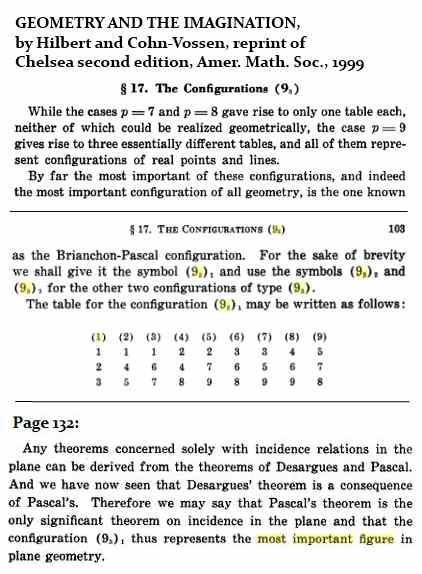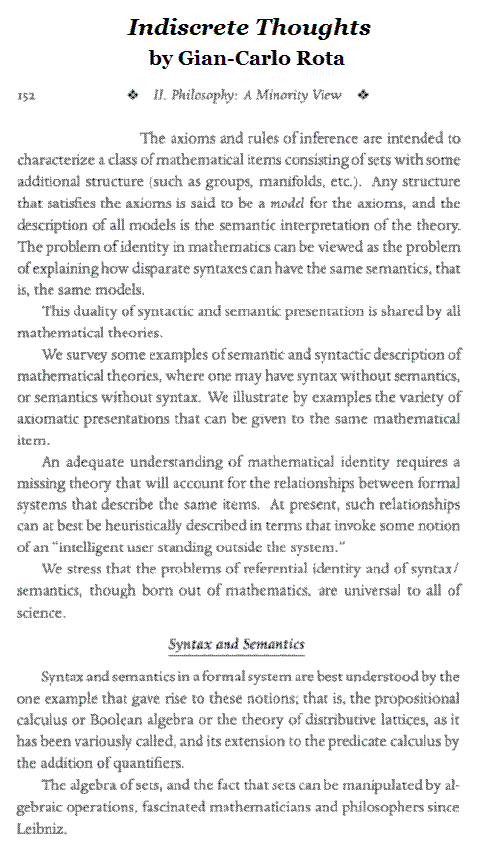See the title in this journal.

https://www.google.com/search?q="in+terms+of+combinational+delight"
" I divide mathematics into discrete and continuous
(prickles and goo, as Alan Watts put it) . . . ."
— Peter J. Cameron on 8 December 2024
"What is a GUI?" —

See also an illustration from "Google's Apple Tree" (Jan. 4, 2010) —

* Title purloined from Gian-Carlo Rota.
Tiptoe through the tulips with Rota and Erickson:
|
Attempts have been made to string together beautiful mathematical results and to present them in books bearing such attractive titles as The One Hundred Most Beautiful Theorems of Mathematics. Such anthologies are seldom found on a mathematician’s bookshelf. The beauty of a theorem is best observed when the theorem is presented as the crown jewel within the context of a theory. — Gian-Carlo Rota in Indiscrete Thoughts |
See also Martin Erickson in this journal . . .
"The proof of Desargues' theorem of projective geometry
comes as close as a proof can to the Zen ideal.
It can be summarized in two words: 'I see!' "
— Gian-Carlo Rota in Indiscrete Thoughts (1997)
Also in that book, originally from a review in Advances in Mathematics,
Vol. 84, Number 1, Nov. 1990, p. 136:
Related material:
Pascal and the Galois nocciolo ,
Conway and the Galois tesseract,
Gardner and Galois.
See also Rota and Psychoshop.
A more specific account of
Outside/Inside box-thinking . . .
|
A connection discovered on April 1, 2013 — |
(Perspective Not as Symbolic Form)
From a post of June 8, 2014 —

See August 6, 2013 — Desargues via Galois.
Analogies — “A : B :: C : D” may be read “A is to B as C is to D.”
Gian-Carlo Rota on Heidegger…
“… The universal as is given various names in Heidegger’s writings….
The discovery of the universal as is Heidegger’s contribution to philosophy….
The universal ‘as‘ is the surgence of sense in Man, the shepherd of Being.
The disclosure of the primordial as is the end of a search that began with Plato….
This search comes to its conclusion with Heidegger.”
— “Three Senses of ‘A is B’ in Heideggger,” Ch. 17 in Indiscrete Thoughts
See also Four Dots in this journal.
Some context: McLuhan + Analogy.
(A Prequel to Dirac and Geometry)
"So Einstein went back to the blackboard.
And on Nov. 25, 1915, he set down
the equation that rules the universe.
As compact and mysterious as a Viking rune,
it describes space-time as a kind of sagging mattress…."
— Dennis Overbye in The New York Times online,
November 24, 2015
Some pure mathematics I prefer to the sagging Viking mattress —
Readings closely related to the above passage —
Thomas Hawkins, "From General Relativity to Group Representations:
the Background to Weyl's Papers of 1925-26," in Matériaux pour
l'histoire des mathématiques au XXe siècle: Actes du colloque
à la mémoire de Jean Dieudonné, Nice, 1996 (Soc. Math.
de France, Paris, 1998), pp. 69-100.
The 19th-century algebraic theory of invariants is discussed
as what Weitzenböck called a guide "through the thicket
of formulas of general relativity."
Wallace Givens, "Tensor Coordinates of Linear Spaces," in
Annals of Mathematics Second Series, Vol. 38, No. 2, April 1937,
pp. 355-385.
Tensors (also used by Einstein in 1915) are related to
the theory of line complexes in three-dimensional
projective space and to the matrices used by Dirac
in his 1928 work on quantum mechanics.
For those who prefer metaphors to mathematics —
Rota fails to cite the source of his metaphor.
|

"The relevance of a geometric theorem is determined by what the theorem
tells us about space, and not by the eventual difficulty of the proof."
— Gian-Carlo Rota discussing the theorem of Desargues
What space tells us about the theorem :
In the simplest case of a projective space (as opposed to a plane ),
there are 15 points and 35 lines: 15 Göpel lines and 20 Rosenhain lines.*
The theorem of Desargues in this simplest case is essentially a symmetry
within the set of 20 Rosenhain lines. The symmetry, a reflection
about the main diagonal in the square model of this space, interchanges
10 horizontally oriented (row-based) lines with 10 corresponding
vertically oriented (column-based) lines.
Vide Classical Geometry in Light of Galois Geometry.
* Update of June 9: For a more traditional nomenclature, see (for instance)
R. Shaw, 1995. The "simplest case" link above was added to point out that
the two types of lines named are derived from a natural symplectic polarity
in the space. The square model of the space, apparently first described in
notes written in October and December, 1978, makes this polarity clearly visible:
Best vs. Bester
The previous post ended with a reference mentioning Rosenhain.
For a recent application of Rosenhain's work, see
Desargues via Rosenhain (April 1, 2013).
From the next day, April 2, 2013:
"The proof of Desargues' theorem of projective geometry
comes as close as a proof can to the Zen ideal.
It can be summarized in two words: 'I see!' "
– Gian-Carlo Rota in Indiscrete Thoughts (1997)
Also in that book, originally from a review in Advances in Mathematics ,
Vol. 84, Number 1, Nov. 1990, p. 136:

See, too, in the Conway-Sloane book, the Galois tesseract …
and, in this journal, Geometry for Jews and The Deceivers , by Bester.
Background: Rosenhain and Göpel Tetrads in PG(3,2)
|
Introduction: The Large Desargues Configuration Added by Steven H. Cullinane on Friday, April 19, 2013 Desargues' theorem according to a standard textbook:
"If two triangles are perspective from a point The converse, from the same book:
"If two triangles are perspective from a line
Desargues' theorem according to Wikipedia
"Two triangles are in perspective axially [i.e., from a line]
A figure often used to illustrate the theorem,
A discussion of the "if and only if" version of the theorem
This large Desargues configuration involves a third triangle,
Point-line incidence in this larger configuration is,
The third triangle, within the larger configuration,
|

A connection discovered today (April 1, 2013)—
(Click to enlarge the image below.)
Update of April 18, 2013
Note that Baker's Desargues-theorem figure has three triangles,
ABC, A'B'C', A"B"C", instead of the two triangles that occur in
the statement of the theorem. The third triangle appears in the
course of proving, not just stating, the theorem (or, more precisely,
its converse). See, for instance, a note on a standard textbook for
further details.
(End of April 18, 2013 update.)
Update of April 14, 2013
See Baker's Proof (Edited for the Web) for a detailed explanation
of the above picture of Baker's Desargues-theorem frontispiece.
(End of April 14, 2013 update.)
Update of April 12, 2013
A different figure, from a site at National Tsing Hua University,
shows the three triangles of Baker's figure more clearly:
(End of update of April 12, 2013)
Update of April 13, 2013
Another in a series of figures illustrating
Desargues's theorem in light of Galois geometry:

See also the original Veblen-Young figure in context.
(End of update of April 13, 2013)

Rota's remarks, while perhaps not completely accurate, provide some context
for the above Desargues-Rosenhain connection. For some other context,
see the interplay in this journal between classical and finite geometry, i.e.
between Euclid and Galois.
For the recent context of the above finite-geometry version of Baker's Vol. I
frontispiece, see Sunday evening's finite-geometry version of Baker's Vol. IV
frontispiece, featuring the Göpel, rather than the Rosenhain, tetrads.
For a 1986 illustration of Göpel and Rosenhain tetrads (though not under
those names), see Picturing the Smallest Projective 3-Space.
In summary… the following classical-geometry figures
are closely related to the Galois geometry PG(3,2):
|
Volume I of Baker's Principles has a cover closely related to the Rosenhain tetrads in PG(3,2) |
Volume IV of Baker's Principles has a cover closely related to the Göpel tetrads in PG(3,2) |
|
Foundations (click to enlarge)
|
Higher Geometry (click to enlarge)
|
"In any geometry satisfying Pappus's Theorem,
the four pairs of opposite points of 83
are joined by four concurrent lines."
— H. S. M. Coxeter (see below)
Continued from Tuesday, Sept. 6—
The Diamond Star

The above is a version of a figure from Configurations and Squares.
Yesterday's post related the the Pappus configuration to this figure.
Coxeter, in "Self-Dual Configurations and Regular Graphs," also relates Pappus to the figure.
Some excerpts from Coxeter—

The relabeling uses the 8 superscripts
from the first picture above (plus 0).
The order of the superscripts is from
an 8-cycle in the Galois field GF(9).
The relabeled configuration is used in a discussion of Pappus—

(Update of Sept. 10, 2011—
Coxeter here has a note referring to page 335 of
G. A. Miller, H. F. Blichfeldt, and L. E. Dickson,
Theory and Applications of Finite Groups , New York, 1916.)
Coxeter later uses the the 3×3 array (with center omitted) again to illustrate the Desargues configuration—

The Desargues configuration is discussed by Gian-Carlo Rota on pp. 145-146 of Indiscrete Thoughts—
"The value of Desargues' theorem and the reason why the statement of this theorem has survived through the centuries, while other equally striking geometrical theorems have been forgotten, is in the realization that Desargues' theorem opened a horizon of possibilities that relate geometry and algebra in unexpected ways."
A search for some background on Gian-Carlo Rota's remarks
in Indiscrete Thoughts * on a geometric configuration
leads to the following passages in Hilbert and Cohn-Vossen's
classic Geometry and the Imagination—

These authors describe the Brianchon-Pascal configuration
of 9 points and 9 lines, with 3 points on each line
and 3 lines through each point, as being
"the most important configuration of all geometry."
Thus it seems worthwhile to relate it to the web page
on square configurations referenced here Tuesday.
The Encyclopaedia of Mathematics , ed. by Michiel Hazewinkel,
supplies a summary of the configuration apparently
derived from Hilbert and Cohn-Vossen—
My own annotation at right above shows one way to picture the
Brianchon-Pascal points and lines— regarded as those of a finite,
purely combinatorial , configuration— as subsets of the nine-point
square array discussed in Configurations and Squares. The
rearrangement of points in the square yields lines that are in
accord with those in the usual square picture of the 9-point
affine plane.
A more explicit picture—

The Brianchon-Pascal configuration is better known as Pappus's configuration,
and a search under that name will give an idea of its importance in geometry.
* Birkhäuser Boston, 1998 2nd printing, p. 145
It was a dark and stormy night…

— Page 180, Logicomix
“… the class of reflections is larger in some sense over an arbitrary field than over a characteristic zero field.”
– Julia Hartmann and Anne V. Shepler, “Jacobians of Reflection Groups”
For some context, see the small cube in “A Simple Reflection Group of Order 168.”
See also the larger cube in “Many Dimensions” + Whitehead in this journal (scroll down to get past the current post).
That search refers to a work by Whitehead published in 1906, the year at the top of the Logicomix page above—

A related remark on axiomatics that has metaphysical overtones suitable for a dark and stormy night—
“An adequate understanding of mathematical identity requires a missing theory that will account for the relationships between formal systems that describe the same items. At present, such relationships can at best be heuristically described in terms that invoke some notion of an ‘intelligent user standing outside the system.'”
— Gian-Carlo Rota, “Syntax, Semantics, and…” in Indiscrete Thoughts . See also the original 1988 article.
A mathematical review—
— Gian-Carlo Rota
A science fiction—
— Alfred Bester
Pythagoreans might regard today as the Day of the Tetraktys.
Some relevant epigraphs—
"Contrary to John Keats's First and Second Laws of Aesthetics ('Beauty is truth, truth beauty') truth and beauty are poles apart. Keats's ode itself, while denying this by precept, bears it out by example. Truth occupies the alethic pole of the intellectual sphere and beauty the aesthetic pole. Each is admirable in its way. The alethic pole exerts the main pull on science, in the broad sense: Wissenschaft, comprising mathematics, history, and all the hard and soft sciences in between. The aesthetic pole is the focus of belles lettres, music, art for art's sake."
— W. V. Quine in Quiddities
Weisheit und Wissenschaft: Studien zu Pythagoras, Philolaos und Platon
— Original title of Burkert's Lore and Science in Ancient Pytthagoreanism
"What song the Sirens sang…" — Sir Thomas Browne
Recommended:
or: Combinatorics (Rota) as Philosophy (Heidegger) as Geometry (Me)
“Dasein’s full existential structure is constituted by
the ‘as-structure’ or ‘well-joined structure’ of the rift-design*…”
— Gary Williams, post of January 22, 2010
Background—
Gian-Carlo Rota on Heidegger…
“… The universal as is given various names in Heidegger’s writings….
The discovery of the universal as is Heidegger’s contribution to philosophy….
The universal ‘as‘ is the surgence of sense in Man, the shepherd of Being.
The disclosure of the primordial as is the end of a search that began with Plato….
This search comes to its conclusion with Heidegger.”
— “Three Senses of ‘A is B’ in Heideggger,” Ch. 17 in Indiscrete Thoughts
… and projective points as separating rifts—
* rift-design— Definition by Deborah Levitt—
“Rift. The stroke or rending by which a world worlds, opening both the ‘old’ world and the self-concealing earth to the possibility of a new world. As well as being this stroke, the rift is the site— the furrow or crack— created by the stroke. As the ‘rift design‘ it is the particular characteristics or traits of this furrow.”
— “Heidegger and the Theater of Truth,” in Tympanum: A Journal of Comparative Literary Studies, Vol. 1, 1998
"We acknowledge a theorem's beauty
when we see how the theorem 'fits'
in its place, how it sheds light around itself,
like a Lichtung, a clearing in the woods."
— Gian-Carlo Rota, Indiscrete Thoughts
Here Rota is referring to a concept of Heidegger.
Some context—
"Gestalt Gestell Geviert: The Way of the Lighting,"
by David Michael Levin in The Philosopher's Gaze
The August 2007 issue of Notices of the American Mathematical Society contains tributes to the admirable personal qualities and mathematical work of the late Harvard professor George Mackey. For my own tributes, see Log24 on March 17, 2006, April 29, 2006, and March 10, 2007. For an entry critical of Mackey’s reductionism– a philosophical, not mathematical, error– see Log24 on May 23, 2007 (“Devil in the Details”).
Here is another attack on reductionism, from a discussion of the work of another first-rate mathematician, the late Gian-Carlo Rota of MIT:
“Another theme developed by Rota is that of ‘Fundierung.’ He shows that throughout our experience we encounter things that exist only as founded upon other things: a checkmate is founded upon moving certain pieces of chess, which in turn are founded upon certain pieces of wood or plastic. An insult is founded upon certain words being spoken, an act of generosity is founded upon something’s being handed over. In perception, for example, the evidence that occurs to us goes beyond the physical impact on our sensory organs even though it is founded upon it; what we see is far more than meets the eye. Rota gives striking examples to bring out this relationship of founding, which he takes as a logical relationship, containing all the force of logical necessity. His point is strongly antireductionist. Reductionism is the inclination to see as ‘real’ only the foundation, the substrate of things (the piece of wood in chess, the physical exchange in a social phenomenon, and especially the brain as founding the mind) and to deny the true existence of that which is founded. Rota’s arguments against reductionism, along with his colorful examples, are a marvelous philosophical therapy for the debilitating illness of reductionism that so pervades our culture and our educational systems, leading us to deny things we all know to be true, such as the reality of choice, of intelligence, of emotive insight, and spiritual understanding. He shows that ontological reductionism and the prejudice for axiomatic systems are both escapes from reality, attempts to substitute something automatic, manageable, and packaged, something coercive, in place of the human situation, which we all acknowledge by the way we live, even as we deny it in our theories.”
— Robert Sokolowski, foreword to Rota’s Indiscrete Thoughts
 Fr. Robert Sokolowski, Ph.D., is Professor of Philosophy at The Catholic University of America in Washington, D.C. Ordained a Roman Catholic priest in 1962, he is internationally recognized and honored for his work in philosophy, particularly phenomenology. In 1994, Catholic University sponsored a conference on his work and published several papers and other essays under the title, The Truthful and the Good, Essays In Honor of Robert Sokolowski. |
The tributes to Mackey are contained in the first of two feature articles in the August 2007 AMS Notices. The second feature article is a review of a new book by Douglas Hofstadter. For some remarks related to that article, see Thursday’s Log24 entry “Not Mathematics but Theology.”
Mathematics and Narrative:
A Two-Part Invention
Here are today's
numbers from the
Keystone State:

The second sentence, in bold type, was added on 8/21 by yours truly. No deep learning or original thought was required to make this important improvement in the article; the sentence was simply copied from the then-current version of the article on Grigori Perelman (who has, it seems, proved the geometrization conjecture).
This may serve as an example of the "mathematics" part of the above phrase "Mathematics and Narrative" — a phrase which served, with associated links, as the Log24 entry for 8/21.
7/23 — Narrative:
This quotation appeared in the Log24 entry for 7/23, "Dance of the Numbers." What Dyson calls a "story" or "drama" is in fact mathematics. (Dyson calls the "steps" in the story "works of art," so it is clear that Dyson (a former student of G. H. Hardy) is discussing mathematical steps, not paragraphs in someone's account– perhaps a work of art, perhaps not– of mathematical history.) I personally regard the rhetorical trick of calling the steps leading to a mathematical result a "story" as contemptible vulgarization, but Dyson, as someone whose work (pdf) led to the particular result he is discussing, is entitled to dramatize it as he pleases.
For related material on mathematics, narrative, and vulgarization, click here.
The art of interpretation (applied above to a lottery) is relevant to narrative and perhaps also, in some sense, to the arts of mathematical research and exposition (if not to mathematics itself). This art is called hermeneutics.
For more on the subject, see the Stanford Encyclopedia of Philosophy article on Hans-Georg Gadamer, "the decisive figure in the development of twentieth-century hermeneutics."
"Foreword" in Gian-Carlo Rota,
Indiscrete Thoughts,
Boston: Birkhäuser Verlag,
1996, xiii-xvii, and
"Gadamer's Theory of Hermeneutics" in
The Philosophy of Hans-Georg Gadamer,
edited by Lewis E. Hahn,
The Library of Living Philosophers, Vol. 24,
Chicago: Open Court Publishers,
1997, 223-34.
— Gian-Carlo Rota in
Indiscrete Thoughts, p. 152
The Devil’s Bible and
Nothing Nothings (Again).
The Context
One context for the Rota quote
is Paul Halmos’s remark, quoted
in today’s New York Times,
that mathematics is
“almost like being
in touch with God.”
Another context is
Log24 on Aug. 29, 2005.

| Date: Sun, 28 Aug 2005 12:30:40 -0400 From: Alf van der Poorten AM Subject: Vale George Szekeres and Esther Klein Szekeres Members of the Number Theory List will be sad to learn that George and Esther Szekeres both died this morning. George, 94, had been quite ill for the last 2-3 days, barely conscious, and died first at 06:30. Esther, 95, died a half hour later. Both George Szekeres and Esther Klein will be recalled by number theorists as members of the group of young Hungarian mathematicians of the 1930s including Turan and Erdos. George and Esther's coming to Australia in the late 40s played an important role in the invigoration of Australian Mathematics. George was also an expert in group theory and relativity; he was my PhD supervisor. Emeritus Professor |
AVE
| "Hello! Kinch here. Put me on to Edenville. Aleph, alpha: nought, nought, one."
"A very short space of time through very short times of space…. — James Joyce, Ulysses, Proteus chapter A very short space of time through very short times of space…. "It is demonstrated that space-time should possess a discrete structure on Planck scales." — Peter Szekeres, abstract of Discrete Space-Time |
Peter Szekeres is the son of George and Esther Szekeres.
"At present, such relationships can at best be heuristically described in terms that invoke some notion of an 'intelligent user standing outside the system.'"
— Gian-Carlo Rota in Indiscrete Thoughts, p. 152
For Otto Preminger's birthday:
Lichtung!
Today's symbol-mongering (see my Sept. 7, 2002, note The Boys from Uruguay) involves two illustrations from the website of the Deutsche Schule Montevideo, in Uruguay. The first, a follow-up to Wallace Stevens's remarks on poetry and painting in my note "Sacerdotal Jargon" of earlier today, is a poem, "Lichtung," by Ernst Jandl, with an illustration by Lucia Spangenberg.
|
manche meinen |
|
|
by Ernst Jandl |
The second, from the same school, illustrates the meaning of "Lichtung" explained in my note The Shining of May 29:
"We acknowledge a theorem's beauty when we see how the theorem 'fits' in its place, how it sheds light around itself, like a Lichtung, a clearing in the woods."
— Gian-Carlo Rota, page 132 of Indiscrete Thoughts, Birkhauser Boston, 1997
From the Deutsche Schule Montevideo mathematics page, an illustration of the Pythagorean theorem:
|
Braucht´s noch Text? |
Powered by WordPress